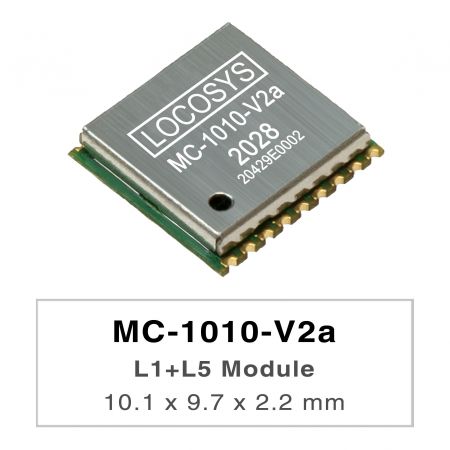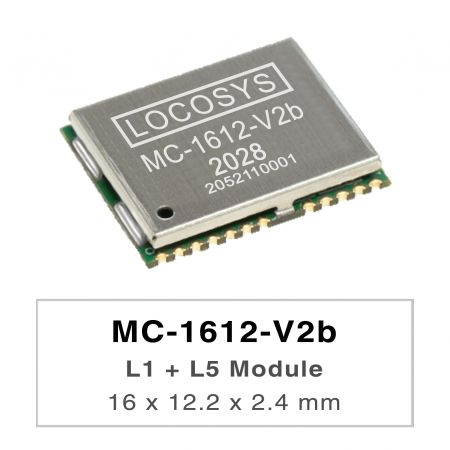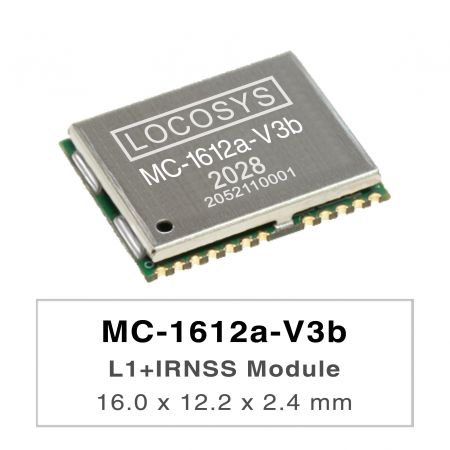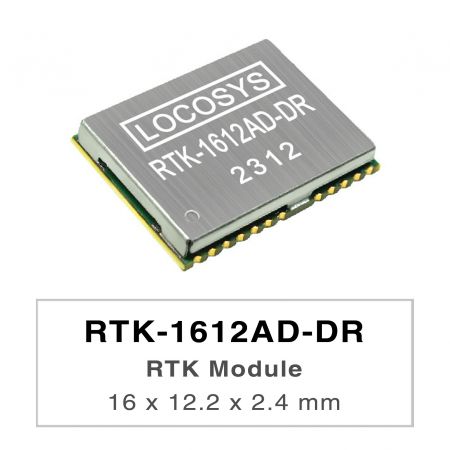-

MC-1010-V2a
MC-1010-V2a
LOCOSYS MC-1010-Vxx series are high-performance dual-band GNSS positioning modules that are capable of tracking all global civil navigation systems. They adopt 12 nm process and integrate efficient power management architecture to perform low power and high sensitivity. Besides, concurrent reception of L1 and L5 band signals mitigates the multipath delay and achieves sub-meter position accuracy. The modules support hybrid ephemeris prediction to achieve faster cold start. One is self-generated ephemeris prediction (called EPOC) that is no need of both network assistance and host CPU’s intervention. This is valid for up to 3 days and updates automatically from time to time when GNSS module is powered on and satellites are available. The other is server-generated ephemeris prediction (called EPO) that gets from an internet server. This is valid for up to 14 days. Both ephemeris predictions are stored in the on-board flash memory and perform a cold start time less than 15 seconds. MC-1010-V3x with the active antenna can comply with the sensitivity specification contained in AIS 140 standard. It is the best solution to those customers that design tracking applications in compliance with AIS 140.
-

MC-1010-V2b
MC-1010-V2b
LOCOSYS MC-1010-Vxx series are high-performance dual-band GNSS positioning modules that are capable of tracking all global civil navigation systems. They adopt 12 nm process and integrate efficient power management architecture to perform low power and high sensitivity. Besides, concurrent reception of L1 and L5 band signals mitigates the multipath delay and achieves sub-meter position accuracy. The modules support hybrid ephemeris prediction to achieve faster cold start. One is self-generated ephemeris prediction (called EPOC) that is no need of both network assistance and host CPU’s intervention. This is valid for up to 3 days and updates automatically from time to time when GNSS module is powered on and satellites are available. The other is server-generated ephemeris prediction (called EPO) that gets from an internet server. This is valid for up to 14 days. Both ephemeris predictions are stored in the on-board flash memory and perform a cold start time less than 15 seconds. MC-1010-V3x with the active antenna can comply with the sensitivity specification contained in AIS 140 standard. It is the best solution to those customers that design tracking applications in compliance with AIS 140.
-

MC-1612a-V2b
MC-1612a-V2b
LOCOSYS MC-1612a-Vxx is a high-performance dual-band GNSS positioning module that is capable of tracking all global civil navigation systems. It adopts 12 nm process and integrates efficient power management architecture to perform low power and high sensitivity. Besides, concurrent reception of L1 and L5 band signals mitigates the multipath delay and achieves more accurate position. The module supports hybrid ephemeris prediction to achieve faster cold start. One is self-generated ephemeris prediction (called EPOC) that is no need of both network assistance and host CPU’s intervention. This is valid for up to 3 days and updates automatically from time to time when GNSS module is powered on and satellites are available. The other is server-generated ephemeris prediction (called EPO) that gets from an internet server. This is valid for up to 14 days. Both ephemeris predictions are stored in the on-board flash memory and perform a faster cold start. The RF front end of MC-161a-V3b the module is specifically designed to comply with sensitivity specification contained in AIS 140 standard. It is the best solution to those customers that design tracking applications in compliance with AIS 140.
-

MC-1612-V2b
MC-1612-V2b
LOCOSYS MC-1612-Vxx series are high-performance dual-band GNSS positioning modules that are capable of tracking all global civil navigation systems. They adopt 12 nm process and integrate efficient power management architecture to perform low power and high sensitivity. Besides, concurrent reception of L1 and L5 band signals mitigates the multipath delay and achieves sub-meter position accuracy. The modules support hybrid ephemeris prediction to achieve faster cold start. One is self-generated ephemeris prediction (called EPOC) that is no need of both network assistance and host CPU’s intervention. This is valid for up to 3 days and updates automatically from time to time when GNSS module is powered on and satellites are available. The other is server-generated ephemeris prediction (called EPO) that gets from an internet server. This is valid for up to 14 days. Both ephemeris predictions are stored in the on-board flash memory and perform a cold start time less than 15 seconds The RF front end of MC-1612-V3b the module is specifically designed to comply with sensitivity specification contained in AIS 140 standard. It is the best solution to those customers that design tracking applications in compliance with AIS 140.
-

MC-1722-T
MC-1722-T
The MC-1722-T is a high-performance L1 and L5 dual-band, multi-frequency GNSS module that designed for timing applications. The module supports concurrent reception of GPS, GLONASS, BeiDou, GALILEO and QZSS to improve the availability and reliability.
-

BK-1612-15
BK-1612-15
The BK-1612-15 is a receiving module that supports Dual-Band & Multi-Mode. It has built-in highly integrated GNSS receiver chip, supports multi band and multi system cm4f (main frequency 350Mhz, 22nm Technology) chip of Third-generation BEIDOU Navigation Satellite System (BDS-3). Besides, it is capable of tracking all global civil navigation systems (GPS, GLONASS, GALILEO, BEIDOU, QZSS, and SBAS) in allbands. BK-1612-15 module is based on the state of art BDS-3 architecture, integrating multi-band and multi-system GNSS RF and baseband. This newly designed architecture makes this single chip achieve sub-meter level positioning accuracy without correction data from ground-based augmentation station and higher sensitivity, greater for improved jam resistance and multipath, provide a highly robust service in complicated environment. BK-1612-15 module contains positioning engine inside, featuring high sensitivity, low power consumption, and fast TTFF. The superior cold start sensitivity allows it to acquire, track, and get position fix autonomously in difficult weak signal environment. The receiver’s superior tracking sensitivity allows continuous position coverage in nearly all outdoor application environments. The high-performance signal parameter searching engine is capable of testing 16 million time-frequency hypotheses per second, offering superior signal acquisition and TTFF speed.
-

SO-1612-15
SO-1612-15
SO-1612-15 is a dual-band GNSS positioning receiving modules that a capable of tracking all global civil navigation systems (BDS, GPS, GLONASS, Galileo, QZSS, IRNSS and SBAS) in all band bands. Built-in highly integrated GNSS receiving chip supports the third generation Beidou Satellite Navigation System (BDS-3). SO-1612-15 module is based on the state of art BDS-3 architecture, integrating multi-band and multi-system GNSS RF and baseband. This newly designed architecture makes this single chip achieve sub-meter level position accuracy without correction data from ground-based augmentation station and higher sensitivity, greater for improved jam resistance and multipath, provide a highly robust service in complicated environment. SO-1612-15 module contains CXD5610GF positioning engine inside, featuring high sensitivity, low power consumption, and fast TTFF. The superior cold start sensitivity allows it to acquire, track, and get position fix autonomously in difficult weak signal environment. The receiver’s superior tracking sensitivity allows continuous position coverage in nearly all outdoor application environments.
-

BK-1612-1N
BK-1612-1N
The BK-1612-1N is a receiving module that supports dual-band and GPS, GLONASS, GALILEO, BEIDOU, QZSS & NavIC Multi-mode. It has built-in highly integrated receiver chip, supports multi band and multi system cm4f (main frequency 350mhz, 22nm Technology) chip. Besides, it is capable of tracking all global civil navigation systems (GPS, GLONASS, GALILEO, BEIDOU, QZSS, NavIC ) in band L1 and L5. BK-1612-1N module is based on the state of art NavIC architecture, integrating multi-band and multi-system GNSS RF and base band. This newly designed architecture makes this single chip achieve sub-meter level positioning accuracy without correction data from ground-based augmentation station and higher sensitivity, greater for improved jam resistance and multipath, provide a highly robust service in complicated environment. BK-1612-1N module featuring high sensitivity, low power consumption, and fast TTFF. The superior cold start sensitivity allows it to acquire, track, and get position fix autonomously in difficult weak signal environment. The receiver’s superior tracking sensitivity allows continuous position coverage in nearly all outdoor application environments. The high performance signal parameter search engine is capable of testing 16 million time-frequency hypotheses per second, offering superior signal acquisition and TTFF speed.
-

MC-1010-V3a
MC-1010-V3a
LOCOSYS MC-1010-Vxx series are high-performance dual-band GNSS positioning modules that are capable of tracking all global civil navigation systems. They adopt 12 nm process and integrate efficient power management architecture to perform low power and high sensitivity. Besides, concurrent reception of L1 and L5 band signals mitigates the multipath delay and achieves sub-meter position accuracy. The modules support hybrid ephemeris prediction to achieve faster cold start. One is self-generated ephemeris prediction (called EPOC) that is no need of both network assistance and host CPU’s intervention. This is valid for up to 3 days and updates automatically from time to time when GNSS module is powered on and satellites are available. The other is server-generated ephemeris prediction (called EPO) that gets from an internet server. This is valid for up to 14 days. Both ephemeris predictions are stored in the on-board flash memory and perform a cold start time less than 15 seconds. MC-1010-V3x with the active antenna can comply with the sensitivity specification contained in AIS 140 standard. It is the best solution to those customers that design tracking applications in compliance with AIS 140.
-

MC-1612a-V3b
MC-1612a-V3b
LOCOSYS MC-1612a-Vxx is a high-performance dual-band GNSS positioning module that is capable of tracking all global civil navigation systems. It adopts 12 nm process and integrates efficient power management architecture to perform low power and high sensitivity. Besides, concurrent reception of L1 and L5 band signals mitigates the multipath delay and achieves more accurate position. The module supports hybrid ephemeris prediction to achieve faster cold start. One is self-generated ephemeris prediction (called EPOC) that is no need of both network assistance and host CPU’s intervention. This is valid for up to 3 days and updates automatically from time to time when GNSS module is powered on and satellites are available. The other is server-generated ephemeris prediction (called EPO) that gets from an internet server. This is valid for up to 14 days. Both ephemeris predictions are stored in the on-board flash memory and perform a faster cold start. The RF front end of MC-161a-V3b the module is specifically designed to comply with sensitivity specification contained in AIS 140 standard. It is the best solution to those customers that design tracking applications in compliance with AIS 140.
-

UB10F-2525e
UB10F-2525e
LOCOSYS proudly announces the launch of its latest GNSS module, the UB10F-2525e, powered by state-of-the-art 10th-generation GNSS chipsets. This new product line integrates multi-constellation reception with support for GPS, GLONASS, Galileo, and BeiDou, delivering advanced high-precision positioning with optimized power management. Even in complex environments such as urban canyons or highly obstructed areas, the UB10F-2525e ensures stable and reliable availability. Backed by LOCOSYS’s extensive experience in high-precision positioning and system integration, the company has successfully helped numerous overseas clients achieve unmanned and autonomous positioning projects, making LOCOSYS the trusted partner of choice. Designed to meet the rapidly growing demand for accuracy, it provides robust solutions for UAVs, AGVs/UGVs, robotics, unmanned vessels, e-bikes, and automotive applications. With LOCOSYS’s expertise in design and system integration, the UB10F-2525e offers meter-level accuracy while maintaining outstanding resilience in dynamic environments. The chipset delivers enhanced RF sensitivity under 25×25 mm patch antenna and weak signal conditions, supported by advanced interference and spoofing detection mechanisms that further strengthen system reliability. This product launch once again underscores LOCOSYS’s long-standing commitment to enabling autonomous and unmanned applications, driving industries toward smarter, more connected, and future-ready mobility and positioning ecosystems. By combining cutting-edge GNSS/RTK technology with proven integration know-how, LOCOSYS continues to empower global partners in building reliable, scalable, and innovative solutions for the next generation of intelligent mobility.
-
-52Q-1.jpg?v=d98f8a7b)
LC20032(M)-52Q
LC20032(M)-52Q
LC20032(M)-52Q is based on the proven technology found in LOCOSYS 47 channel GNSS SMD type receiver MG-1612-52Q that uses Airoha chip solution, designed for a broad spectrum of OEM system applications. This module providing fast time-to-first-fix, one-second navigation update and low power consumption. It can provide you with superior sensitivity and performance even in urban canyon and dense foliage environment. Its far-reaching capability meets the sensitivity requirements of car navigation as well as other location-based applications. This module supports hybrid ephemeris prediction to achieve faster cold start. One is self-generated ephemeris prediction that is no need of both network assistance and host CPU’s intervention. This is valid for up to 3 days and updates automatically from time to time when GNSS module is powered on and satellites are available. The other is server-generated ephemeris prediction that gets from an internet server. This is valid for up to 14 days. Both ephemeris predictions are stored in the on-board flash memory and perform a faster cold start time.
-

LC2003x-52Q
LC2003x-52Q
LC2003x-52Q Series is a high-performance L1-band GNSS smart antenna module that integrates a powerful GNSS receiver with a compact embedded patch antenna. Designed for a wide range of OEM system applications, this module offers fast time-to-first-fix (TTFF), superior sensitivity, and low power consumption, delivering reliable positioning even in challenging urban or obstructed environments. It is an ideal solution for automotive navigation, asset tracking, and various location-based services (LBS) where accuracy and responsiveness are critical. LC20031-52Qe model is equipped with a built-in e-compass. It supports a default 5Hz high update rate in UBX protocol format, delivering low- latency output and smooth real-time performance making it particularly well-suited for drone navigation, autonomous systems, and other dynamic applications that demand stable and high- frequency position updates.
-

MGS-1818-52Q
MGS-1818-52Q
MGS-1818-52Q is a complete standalone multi-frequency GNSS smart antenna module, including embedded patch antenna and GNSS receiver circuits which is based Airoha AG3352Q platform. The module can simultaneously acquire and track multiple satellite constellations that include GPS, GLONASS, GALILEO, BAIDOU, and QZSS simultaneously, which in combination with the support of SBAS, greatly increases the number of visible satellites and enhances positioning accuracy. Its superior cold-start sensitivity allows it to acquire, track, and get position fix autonomously in difficult weak signal environment. Its superior tracking sensitivity allows continuous position coverage in nearly all outdoor application environments. The module supports hybrid ephemeris prediction to achieve faster cold start. One is self-generated ephemeris prediction (called EASY) that is no need of both network assistance and host CPU’s intervention. This is valid for up to 3 days and updates automatically from time to time when GNSS module is powered on and satellites are available. The other is server-generated ephemeris prediction (called EPO) that gets from an internet server. This is valid for up to 14 days. Both ephemeris predictions are stored in the on-board flash memory and perform a cold start time less than 15 seconds. The faster GNSS fixes make it possible to use accurate positioning and navigation services anytime and anywhere with a smaller power budget than previously possible. Available in a cost-optimized version as well as a low-power version which supports for the Adaptive Low Power (ALP) feature in fitness and normal navigation modes.
-

MGS-1513-52Q
MGS-1513-52Q
MGS-1513-52Q is a complete standalone multi-frequency GNSS smart antenna module, including embedded patch antenna and GNSS receiver circuits which is based Airoha AG3352Q platform. The module can simultaneously acquire and track multiple satellite constellations that include GPS, GLONASS, GALILEO, BAIDOU, and QZSS simultaneously, which in combination with the support of SBAS, greatly increases the number of visible satellites and enhances positioning accuracy. Its superior cold-start sensitivity allows it to acquire, track, and get position fix autonomously in difficult weak signal environment. Its superior tracking sensitivity allows continuous position coverage in nearly all outdoor application environments. The module supports hybrid ephemeris prediction to achieve faster cold start. One is self-generated ephemeris prediction (called EASY) tha is no need of both network assistance and host CPU’s intervention. This is valid for up to 3 days and updates automatically from time to time when GNSS module is powered on and satellites are available. The other is server-generated ephemeris prediction (called EPO) that gets from an internet server. This is valid for up to 14 days. Both ephemeris predictions are stored in the on-board flash memory and perform a cold start time less than 15 seconds. The faster GNSS fixes make it possible to use accurate positioning and navigation services anytime and anywhere with a smaller power budget than previously possible. Available in a cost-optimized version as well as a low-power version which supports for the Adaptive Low Power (ALP) feature in fitness and normal navigation modes.
-

LC2003x-35AD
LC2003x-35AD
LC2003x-35AD series products are high-performance dual-band GNSS UDR (Untethered Dead Reckoning) smart antenna modules, including an embedded antenna and GNSS receiver circuits, designed for a broad spectrum of OEM system applications. The GNSS smart antenna will acquire both L1 and L5 signals at a time while providing the better standalone position accuracy and continue to work where GNSS signals are poor or not available. It can provide user with fast Time-To-First-Fix, superior sensitivity and low power consumption.
-

LC2003x-Vx
LC2003x-Vx
LC2003x-Vx series products are high-performance dual-band GNSS smart antenna modules, including an embedded antenna and GNSS receiver circuits, designed for a wide rage of OEM system applications. The GNSS smart antenna can support L1 only signals, or support both L1 and L5 signals, while providing better standalone position accuracy. It can provide fast Time-To-First-Fix, superior sensitivity and low power consumption, delivering reliable positioning even in challenging urban or obstructed environments. It is an ideal solution for automotive navigation, asset tracking, and various location-based services (LBS) where accuracy and responsiveness are critical. LC20031-V2e model is equipped with a built-in e-compass. It supports a default 5Hz high update rate in UBX protocol format, delivering low- latency output and smooth real-time performance making it particularly well-suited for drone navigation, autonomous systems, and other dynamic applications that demand stable and high- frequency position updates.
-

GNSS-DUAL
GNSS-DUAL
GNSS-DUAL is a dual-frequency GNSS compass module that designed for applications requiring accurate dual-antenna GNSS-based heading. The dual-antenna GNSS-based heading is not subject to magnetic interference. Unlike a standard GNSS module that can only estimate heading based on the movement, GNSS-DUAL provides an accurate heading even while the vehicle is stationary. It is capable of concurrently tracking all global civil navigation systems, including GPS, GLONASS, GALILEO, BEIDOU and QZSS. It acquires both L1 and L5 signals at a time while providing accurate heading between dual antennas. GNSS-DUAL adopts 12nm process and integrates efficient power management architecture to become one of the leading groups with the lightest weight and lowest power consumption on the market.
-

RTK-1010
RTK-1010
The RTK-1010 is a high-performance dual-band GNSS RTK module that designed for applications requiring centimeter level positioning accuracy. It adopts 12 nm process and integrate efficient power management architecture to perform low power and high sensitivity. The module supports concurrent reception of GPS, GLONASS, BeiDou, GALILEO, and QZSS to improve the availability and reliability of RTK solution even in the harsh environment.
-

RTK-1612
RTK-1612
The RTK-1612 is a high-performance dual-band GNSS RTK module that designed for applications requiring centimeter level positioning accuracy. It adopts 12 nm process and integrate efficient power management architecture to perform low power and high sensitivity. The module supports concurrent reception of GPS, GLONASS, BeiDou, GALILEO, and QZSS to improve the availability and reliability of RTK solution even in the harsh environment.
-

RTK-1612AD-DR
RTK-1612AD-DR
LOCOSYS RTK-1612AD-DR uses an Airoha AG3335AD chip, dual-frequency multi-constellation solution GNSS, providing RTK high precision and sensor fusion solution in one. It not only supports GPS, GLONASS, GALILEO, BEIDOU, and QZSS but also has inertial sensors (3-axis accelerometers and 3-axis gyros) to provide an untethered dead reckoning function. In addition to DR, an inertial sensor can detect the vehicular dynamics when it is attached firmly on the vehicle. Consequently, abnormal driving behaviors and the vehicle status can be detected and the alarm status will be enabled to remind the users. No requirement of installation orientation and automatic calibration function make it easy to use. With these features, RTK-1612AD-DR can reduce position errors in multipath environment and continue to work where GNSS signals are poor or not available, such as tunnels and indoor parking lots, as well as deliver seamless navigation.
-

BKR-1612
BKR-1612
The BKR-1612 is a receiving module that supports Dual-Band & Multi-Mode. It has built-in highly integrated GNSS receiver chip, supports multi band and multi system cm4f (main frequency 350Mhz, 22nm Technology) chip of Third-generation BEIDOU Navigation Satellite System (BDS-3). Besides, it is capable of tracking all global civil navigation systems (GPS, GLONASS, GALILEO, BEIDOU, QZSS, IRNSS and SBAS) in all bands. BKR-1612 module is based on the state of art BDS-3 architecture, integrating multi-band and multi-system GNSS RF and baseband. This newly designed architecture makes this single chip achieve sub-meter level positioning accuracy without correction data from ground-based augmentation station and higher sensitivity, greater for improved jam resistance and multipath, provide a highly robust service in complicated environment. BKR-1612 module contains positioning engine inside, featuring high sensitivity, low power consumption, and fast TTFF. The superior cold start sensitivity allows it to acquire, track, and get position fix autonomously in difficult weak signal environment. The receiver’s superior tracking sensitivity allows continuous position coverage in nearly all outdoor application environments. The high-performance signal parameter searching engine is capable of testing 16 million time-frequency hypotheses per second, offering superior signal acquisition and TTFF speed.
-

BKR3-1612
BKR3-1612
The BKR3-1612 GNSS module, developed by LOCOSYS Technology Inc., is engineered for applications requiring high-precision positioning and exceptional reliability. Built upon an advanced GNSS SoC architecture and incorporating the latest BDS-3 (BeiDou Navigation Satellite System) framework, the module supports multi-band and multi-constellation reception capabilities. It can concurrently track all major global satellite navigation systems, including GPS, GLONASS, Galileo, BEIDOU, QZSS, IRNSS, and SBAS, while offering full support for L1, L2, and L5 triple-band signal reception with centimeter-level RTK positioning accuracy. At the core of the module is the Beken chip, featuring a 32-bit DSP processor built on 22nm process technology and capable of operating at up to 350MHz. The chip supports up to 200 tracking channels and integrates a dedicated high-performance search engine. It delivers excellent sensitivity across cold start, hot start, and reacquisition modes (from -148dBm to -165dBm), ensuring stable and reliable positioning performance even in challenging signal environments such as dense urban areas or under canopy. The Beken also supports AGPS, RTCM3.X, and offers a maximum update rate of 20Hz, enhancing system responsiveness in dynamic applications.
Press Release
-
 Taiwan Excellence Drone Alliance Visits LOCOSYS Technology, Focusing On Global Positioning Technology And Drone Applications
Taiwan Excellence Drone Alliance Visits LOCOSYS Technology, Focusing On Global Positioning Technology And Drone ApplicationsThe Taiwan Excellence Drone Overseas Business Alliance, led by Yen Tung-Piao,visited a leading smart manufacturing enterprise with a delegation includingrepresentatives from AIDC, the Industrial...
Read More -
 LOCOSYS Showcases Advanced Smart Positioning Technology At New Taipei Electric Vehicle Supply Chain Expo
LOCOSYS Showcases Advanced Smart Positioning Technology At New Taipei Electric Vehicle Supply Chain ExpoTo promote the development of Taiwan's electric vehicle (EV) industry and enhance international collaboration, the New Taipei City Government hosted the Electric Vehicle Supply Chain Expo...
Read More -
 LOCOSYS Technology Unveils New High-Performance SONY GNSS/RTK Global Satellite Positioning Modules
LOCOSYS Technology Unveils New High-Performance SONY GNSS/RTK Global Satellite Positioning ModulesLOCOSYS will showcase its advanced RTK solutions and high-performance GNSS modules, including those powered by Sony’s latest GPS technology, at the 2024 Sensor Expo in Tokyo. These modules,...
Read More

